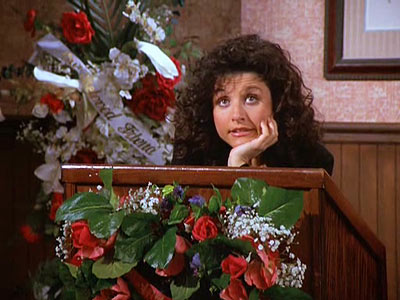Seinfeld: You Got To Have Three
Published on November 29th, 2010 in: Comedy, Issues, Three Of A Perfect Pair, TV |By AJ Wood
Comedy duos are always the front of our minds, as though funny only happens in pairs: Lucy and Desi, Burns and Allen, McCain and Palin. For me, as typified in that first sentence, three is the funniest of numbers: one and two set up the pattern and three knocks them down. Works every time.
What becomes even funnier is using the same structure on top of itself: having three different series of three gags which are each funny on their own, but funnier still when they come together to form something greater. Something like a comedy turducken: nothing is left to idle stuffing; it’s just meat on meat on meat. Or perhaps as a vegetarian, I should say a comedy Voltron, with powerful parts coming together to make something more. Or maybe I should stop giggling over the fact I just wrote “meat on meat on meat” and “powerful parts coming together” and move on to the next slide.
One of the best examples of seamless tripartite comedy writing comes from an unassuming source: the show about nothing, Seinfeld. Running from mid-1989 through the 1997 TV season, this sitcom created by Jerry Seinfeld and Larry David offered something fresh and different from more typical sitcom formats. While “about nothing,” it was still quite unlike anything else on the air. One well-known episode from the early years setting this show apart was “The Chinese Restaurant” (Season 2, Episode 11): a continuous 22 minutes of Jerry, Elaine, and George waiting for a table in a restaurant. Pretty standard fare for a one-act stage comedy perhaps, but definitely not the realm of the typical sitcom.

As the show matured, especially around the third season, the writers became more efficient, weaving more comedic situations into just four main characters. Through the mid-seasons, this structure had practically become a fifth character of the series; like when watching a mystery, you were waiting to see how all these seemingly-disparate story lines would coalesce into comedy gold.
Case in point: “The Susie,” Episode 11 from Season 8. It’s an episode near and dear to my heart as it heavily features Julia Louis-Dreyfus’s Elaine, a wonderful addition to the hilarious frantic traditions of Lucille Ball, Nanette Fabray, and Mary Tyler Moore. It also typifies what became standard on Seinfeld: three separate stories which, while all happening concurrently in their own space, used each other to propel themselves along.
To wit, a break down of the three stories of “The Susie” (spoiler alert!):
First Storyline:
Elaine is called “Susie” by her co-worker Peggy. This puts Elaine off, but it’s too awkward to make a correction. Later they meet again and just as Elaine is about to correct her, Peggy starts to actually complain to Elaine about this “Elaine Benes person.” Elaine loser her temper, but still does not let on that she is not Susie. Eventually things escalate and the boss, Mr. Peterman, calls a meeting to clear the air with Peggy, Elaine, and Susie. In this awkward meeting, Elaine frequently uses the pronoun “she” and gestures to herself and to the empty chair Susie was to occupy. She is able to double-talk her way out of it; Peterman is convinced the problem is solved.
The next day, when Peterman tells Elaine he’s going to give Susie a big new assignment, Elaine tells him that Susie has just committed suicide the night before. Peterman is stunned and goes on to plan a whole memorial service for her, one in which Elaine has to eulogize the imaginary Susie. When Peterman takes the podium, and starts his eulogy, detailing a night he and Susie were working late and gave in to temptation, everyone is quite relieved when he is interrupted by the arrival of an unexpected guest.
Time limit is exhausted. Please reload the CAPTCHA.